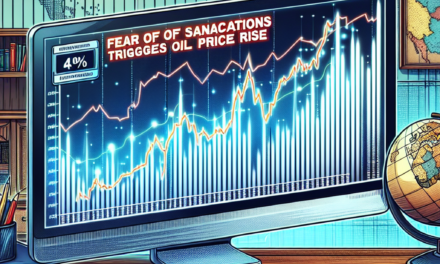“TI Projects Q4 Dip: Industrial Chip Demand Slows Momentum”
Introduction
In the fourth quarter, Texas Instruments (TI) reported financial results that fell below market expectations, primarily due to weakened demand in the industrial chip sector. As a leading player in the semiconductor industry, TI’s performance is often seen as a bellwether for broader market trends. The company faced headwinds from a slowdown in industrial chip orders, which are crucial components in a wide range of applications, from manufacturing to automotive systems. This decline in demand reflects broader economic uncertainties and challenges within the industrial sector, impacting TI’s revenue and profit margins. Despite these challenges, TI remains focused on strategic investments and innovation to navigate the current market landscape and position itself for future growth.
Analysis Of TI’s Q4 Performance: Factors Behind The Decline
Texas Instruments (TI), a leading player in the semiconductor industry, recently reported its fourth-quarter performance, which fell short of market expectations. This underperformance can be attributed to a confluence of factors, primarily revolving around the sluggish demand for industrial chips. As the global economy grapples with various challenges, the semiconductor sector, which had previously experienced a robust growth trajectory, is now facing headwinds that are impacting companies like TI.
One of the primary factors contributing to TI’s disappointing Q4 results is the slowdown in industrial chip demand. The industrial sector, a significant consumer of semiconductors, has been experiencing a deceleration in growth due to several macroeconomic factors. The ongoing geopolitical tensions, coupled with supply chain disruptions, have led to a cautious approach by industries in terms of capital expenditure. Consequently, this has resulted in a reduced demand for industrial chips, which are integral to various applications ranging from automation to energy management.
Moreover, the global semiconductor market is currently navigating through a period of inventory correction. During the pandemic, there was a surge in demand for electronic devices, leading to an unprecedented increase in semiconductor production. However, as the world gradually returns to normalcy, the demand for these devices has stabilized, leading to an excess inventory of chips. This oversupply situation has compelled companies like TI to adjust their production and sales strategies, thereby impacting their financial performance.
In addition to these industry-specific challenges, TI’s Q4 performance was also affected by broader economic conditions. Inflationary pressures have been mounting globally, leading to increased costs for raw materials and logistics. These rising costs have squeezed profit margins for semiconductor manufacturers, including TI. Furthermore, central banks around the world have been tightening monetary policies to combat inflation, resulting in higher interest rates. This has led to a slowdown in economic growth, further dampening the demand for semiconductors across various sectors.
Despite these challenges, it is important to note that TI remains a formidable player in the semiconductor industry. The company has a diversified product portfolio and a strong presence in key markets, which positions it well for future growth. TI’s strategic focus on research and development continues to drive innovation, enabling the company to stay ahead of technological advancements. Additionally, TI’s robust financial health provides it with the resilience needed to navigate through these turbulent times.
Looking ahead, there are several factors that could potentially drive a recovery in TI’s performance. The ongoing digital transformation across industries is expected to spur demand for semiconductors in the long term. As companies increasingly adopt technologies such as the Internet of Things (IoT), artificial intelligence (AI), and 5G, the demand for advanced chips is likely to witness an upswing. Furthermore, government initiatives aimed at bolstering domestic semiconductor production could provide additional support to the industry.
In conclusion, while TI’s Q4 performance was below expectations due to sluggish industrial chip demand and broader economic challenges, the company’s strong fundamentals and strategic initiatives position it well for future growth. As the semiconductor industry continues to evolve, TI’s ability to adapt and innovate will be crucial in overcoming current challenges and capitalizing on emerging opportunities.
Impact Of Sluggish Industrial Chip Demand On TI’s Revenue
Texas Instruments (TI), a leading player in the semiconductor industry, has recently reported that its fourth-quarter projects have fallen below expectations, primarily due to a sluggish demand for industrial chips. This downturn in demand has had a significant impact on the company’s revenue, highlighting the intricate relationship between market demand and financial performance. As the global economy grapples with various challenges, the semiconductor industry, which is often seen as a bellwether for technological advancement and economic health, is not immune to these fluctuations.
The industrial sector, a major consumer of TI’s semiconductor products, has been experiencing a slowdown. This sector encompasses a wide range of applications, from manufacturing and automation to energy and transportation. The reduced demand in these areas can be attributed to several factors, including geopolitical tensions, supply chain disruptions, and a general economic slowdown. These challenges have led to a cautious approach by companies in the industrial sector, resulting in delayed investments and reduced orders for semiconductor components.
Moreover, the semiconductor industry is characterized by its cyclical nature, with periods of high demand often followed by downturns. The current phase of sluggish demand is part of this cycle, exacerbated by external factors such as the ongoing trade tensions between major economies and the lingering effects of the COVID-19 pandemic. These issues have contributed to a climate of uncertainty, prompting companies to reassess their production and investment strategies.
In response to these challenges, TI has been focusing on optimizing its operations and adjusting its production levels to align with the current market conditions. The company has also been exploring opportunities to diversify its product offerings and expand into emerging markets, which could potentially offset the decline in demand from traditional industrial sectors. However, these strategic initiatives may take time to yield significant results, and the immediate impact on revenue remains a concern.
Furthermore, the slowdown in industrial chip demand has broader implications for the semiconductor industry as a whole. It underscores the importance of innovation and adaptability in navigating market fluctuations. Companies that can swiftly adjust their strategies and leverage new technologies are more likely to weather such downturns successfully. For TI, this means not only focusing on its core competencies but also exploring new avenues for growth, such as the burgeoning fields of artificial intelligence and the Internet of Things (IoT).
In conclusion, the sluggish demand for industrial chips has undeniably impacted TI’s revenue projections for the fourth quarter. While the company is taking steps to mitigate these effects, the broader economic and geopolitical landscape continues to pose challenges. As TI navigates this complex environment, its ability to adapt and innovate will be crucial in maintaining its competitive edge. The situation serves as a reminder of the interconnectedness of global markets and the need for companies to remain agile in the face of uncertainty. As the semiconductor industry continues to evolve, the lessons learned from this period will likely shape the strategies of TI and its peers in the years to come.
Strategies For TI To Overcome Q4 Challenges In The Chip Market
Texas Instruments (TI), a leading player in the semiconductor industry, has recently faced challenges in the fourth quarter due to a sluggish demand for industrial chips. This downturn has prompted the company to reassess its strategies to navigate the current market landscape effectively. As TI grapples with these challenges, it is crucial to explore potential strategies that could help the company overcome the obstacles it faces in the chip market.
To begin with, diversifying its product portfolio could be a pivotal strategy for TI. By expanding its offerings beyond industrial chips, TI can tap into other growing sectors such as automotive, consumer electronics, and telecommunications. These sectors have shown resilience and growth potential, even amid broader economic uncertainties. By leveraging its expertise in analog and embedded processing technologies, TI can develop innovative solutions tailored to these markets, thereby mitigating the impact of reduced industrial chip demand.
Moreover, enhancing research and development (R&D) efforts is another critical approach for TI. Investing in R&D can lead to the creation of cutting-edge technologies that meet the evolving needs of various industries. By staying at the forefront of technological advancements, TI can maintain its competitive edge and attract new customers. Additionally, fostering collaborations with academic institutions and research organizations can provide TI with fresh insights and access to emerging technologies, further strengthening its R&D capabilities.
In addition to diversifying its product portfolio and bolstering R&D, TI should also consider optimizing its supply chain management. The semiconductor industry has been plagued by supply chain disruptions, which have exacerbated the challenges faced by companies like TI. By adopting advanced supply chain management practices, such as real-time data analytics and predictive modeling, TI can enhance its ability to anticipate and respond to disruptions. This proactive approach can help ensure a steady supply of raw materials and components, thereby minimizing production delays and meeting customer demands more effectively.
Furthermore, expanding its global footprint could be a strategic move for TI. By establishing a stronger presence in emerging markets, TI can tap into new customer bases and reduce its reliance on traditional markets. Emerging economies often present unique opportunities for growth, driven by increasing industrialization and technological adoption. By tailoring its products and marketing strategies to suit the specific needs of these markets, TI can position itself as a key player in regions with high growth potential.
Additionally, strengthening customer relationships is paramount for TI to navigate the current market challenges. By fostering strong partnerships with its existing customers, TI can gain valuable insights into their evolving needs and preferences. This customer-centric approach can lead to the development of customized solutions that address specific pain points, thereby enhancing customer satisfaction and loyalty. Moreover, by providing exceptional customer service and support, TI can differentiate itself from competitors and build long-term relationships that withstand market fluctuations.
In conclusion, while TI faces significant challenges in the fourth quarter due to sluggish industrial chip demand, there are several strategies it can employ to overcome these obstacles. By diversifying its product portfolio, enhancing R&D efforts, optimizing supply chain management, expanding its global footprint, and strengthening customer relationships, TI can position itself for success in the ever-evolving chip market. These strategies, when implemented effectively, can help TI navigate the current downturn and emerge stronger in the face of future challenges.
Comparing TI’s Q4 Results With Competitors In The Semiconductor Industry

Texas Instruments (TI), a prominent player in the semiconductor industry, recently reported its fourth-quarter results, which fell short of market expectations. This underperformance can be largely attributed to a sluggish demand for industrial chips, a sector that has been a significant revenue driver for the company. As we delve into TI’s Q4 results, it is essential to compare them with those of its competitors to gain a comprehensive understanding of the current landscape in the semiconductor industry.
To begin with, TI’s revenue for the fourth quarter showed a noticeable decline compared to the same period last year. This downturn is primarily due to a decrease in demand from industrial sectors, which have been grappling with economic uncertainties and supply chain disruptions. In contrast, some of TI’s competitors, such as Analog Devices and NXP Semiconductors, have managed to maintain relatively stable performances. These companies have benefited from their diversified portfolios and strategic investments in high-growth areas like automotive and communications, which have helped offset the weaknesses in industrial demand.
Moreover, TI’s gross margins have also been under pressure, reflecting the challenges in managing production costs amid fluctuating demand. Competitors like Broadcom and Qualcomm have demonstrated resilience in this regard, leveraging their scale and operational efficiencies to maintain healthy margins. These companies have capitalized on the robust demand for chips in consumer electronics and data centers, sectors that have shown remarkable growth despite broader economic headwinds.
Furthermore, TI’s strategic focus on analog and embedded processing solutions, while traditionally a strength, has faced headwinds due to the cyclical nature of the industrial market. In contrast, companies like NVIDIA and AMD have thrived by tapping into the burgeoning demand for graphics processing units (GPUs) and advanced computing solutions. These segments have experienced exponential growth, driven by trends such as artificial intelligence, gaming, and cloud computing, which have remained resilient even in challenging economic conditions.
In addition, TI’s investment in research and development, although substantial, has not translated into immediate gains, as the company continues to navigate the complexities of the industrial market. On the other hand, competitors like Intel have aggressively pursued innovation, particularly in areas like semiconductor manufacturing technology and process advancements. This focus on cutting-edge technology has enabled them to capture market share and position themselves favorably for future growth.
It is also worth noting that TI’s approach to capital allocation, characterized by a conservative stance on mergers and acquisitions, contrasts with the strategies of some of its peers. Companies like Marvell Technology have pursued strategic acquisitions to enhance their product offerings and expand into new markets, thereby driving growth and shareholder value.
In conclusion, while TI’s Q4 results have been disappointing, they underscore the broader challenges facing the semiconductor industry, particularly in the industrial segment. However, by comparing TI’s performance with that of its competitors, it becomes evident that diversification, strategic investments, and innovation are key differentiators in navigating the current market dynamics. As the industry continues to evolve, TI may need to reassess its strategies to better align with emerging trends and capitalize on new opportunities. This comparative analysis highlights the importance of adaptability and foresight in maintaining competitiveness in the ever-changing semiconductor landscape.
The Role Of Global Economic Conditions In TI’s Q4 Performance
Texas Instruments (TI), a leading player in the semiconductor industry, has recently reported that its fourth-quarter projects have fallen below expectations, primarily due to sluggish demand for industrial chips. This development has raised concerns among investors and industry analysts, prompting a closer examination of the global economic conditions that have contributed to this downturn. Understanding the interplay between these economic factors and TI’s performance is crucial for stakeholders seeking to navigate the current landscape.
To begin with, the global economy has been grappling with a series of challenges that have collectively dampened industrial demand. The lingering effects of the COVID-19 pandemic continue to disrupt supply chains, leading to production delays and increased costs. These disruptions have been exacerbated by geopolitical tensions, such as trade disputes and regional conflicts, which have further strained international trade relations. Consequently, businesses across various sectors have been hesitant to invest in new technologies, including industrial chips, as they navigate these uncertainties.
Moreover, inflationary pressures have emerged as a significant concern for the global economy. Rising costs of raw materials, energy, and labor have led to increased production expenses for manufacturers. In response, many companies have adopted a cautious approach, prioritizing cost-cutting measures over capital expenditures. This shift in focus has directly impacted the demand for industrial chips, as businesses delay or scale back their investment in new equipment and technologies.
In addition to these challenges, the semiconductor industry itself is experiencing a period of transition. The rapid advancement of technology has led to shorter product life cycles, necessitating continuous innovation and adaptation. While TI has historically been successful in navigating these changes, the current economic climate has made it more difficult to predict and respond to market demands. As a result, the company has faced increased competition from both established players and emerging startups, further complicating its efforts to maintain its market position.
Furthermore, the global push towards sustainability and environmental responsibility has influenced industrial demand patterns. Companies are increasingly prioritizing energy-efficient solutions and sustainable practices, which has shifted the focus away from traditional industrial applications. While TI has made strides in developing eco-friendly technologies, the transition has been gradual, and the immediate impact on demand for its industrial chips has been less pronounced.
Despite these challenges, it is important to recognize that TI’s long-term prospects remain promising. The company has a strong track record of innovation and adaptability, which positions it well to capitalize on emerging opportunities. As the global economy stabilizes and businesses regain confidence, the demand for industrial chips is expected to rebound. Additionally, TI’s investments in research and development, as well as its strategic partnerships, will likely yield positive results in the future.
In conclusion, the underperformance of TI’s fourth-quarter projects can be attributed to a confluence of global economic conditions that have dampened industrial chip demand. While these challenges are significant, they are not insurmountable. By understanding the broader economic context and leveraging its strengths, TI can navigate this period of uncertainty and emerge stronger in the long run. As stakeholders continue to monitor the situation, it is essential to maintain a balanced perspective, recognizing both the immediate challenges and the potential for future growth.
Future Outlook For TI Amidst Weak Industrial Chip Demand
Texas Instruments (TI), a prominent player in the semiconductor industry, has recently faced challenges as its Q4 projections fell below expectations, primarily due to sluggish demand in the industrial chip sector. This downturn in demand has raised concerns about the company’s future outlook, prompting analysts and stakeholders to closely examine the factors contributing to this trend and the potential strategies TI might employ to navigate these turbulent waters.
To begin with, the industrial chip market, a significant segment for TI, has been experiencing a slowdown. This deceleration can be attributed to several macroeconomic factors, including global supply chain disruptions and geopolitical tensions, which have collectively dampened industrial production and investment. As a result, companies across various sectors have scaled back their orders for industrial chips, directly impacting TI’s sales and revenue forecasts. Moreover, the lingering effects of the COVID-19 pandemic have further exacerbated these challenges, as many industries are still grappling with the aftermath of lockdowns and reduced consumer demand.
In light of these circumstances, TI’s management has acknowledged the need to adapt its strategies to better align with the current market environment. One potential avenue for growth lies in diversifying its product portfolio to reduce reliance on the industrial sector. By expanding into other burgeoning markets, such as automotive and consumer electronics, TI could mitigate the risks associated with sector-specific downturns. Additionally, the company could leverage its expertise in analog and embedded processing technologies to develop innovative solutions that cater to emerging trends, such as the Internet of Things (IoT) and renewable energy.
Furthermore, TI’s commitment to research and development (R&D) remains a cornerstone of its long-term strategy. By investing in cutting-edge technologies and fostering a culture of innovation, the company aims to maintain its competitive edge and drive future growth. This focus on R&D not only positions TI to capitalize on new opportunities but also enhances its ability to respond to evolving customer needs and market dynamics.
In parallel, TI is likely to explore strategic partnerships and collaborations to bolster its market presence and expand its reach. By joining forces with other industry leaders, the company can tap into new customer bases and access complementary technologies that enhance its product offerings. Such alliances could prove instrumental in navigating the current challenges and positioning TI for sustained success in the future.
Moreover, TI’s financial resilience provides a solid foundation for weathering the current downturn. With a robust balance sheet and a history of prudent financial management, the company is well-equipped to invest in growth initiatives and withstand short-term market fluctuations. This financial stability not only instills confidence among investors but also enables TI to pursue strategic acquisitions that could further strengthen its market position.
In conclusion, while the sluggish demand for industrial chips presents a formidable challenge for Texas Instruments, the company’s proactive approach to diversification, innovation, and strategic partnerships offers a promising path forward. By leveraging its strengths and adapting to the evolving market landscape, TI is poised to navigate the current headwinds and emerge stronger in the long run. As the semiconductor industry continues to evolve, TI’s ability to anticipate and respond to changing dynamics will be crucial in shaping its future trajectory and ensuring sustained growth and profitability.
Lessons Learned From TI’s Q4 Performance: A Path Forward
Texas Instruments (TI), a stalwart in the semiconductor industry, recently reported its fourth-quarter performance, which fell short of market expectations. This underperformance can be attributed primarily to sluggish demand in the industrial chip sector, a key market for the company. As TI navigates these challenges, there are valuable lessons to be gleaned from its experience, offering insights into how the company and the broader industry might chart a path forward.
To begin with, the decline in industrial chip demand underscores the cyclical nature of the semiconductor industry. Economic fluctuations, geopolitical tensions, and supply chain disruptions have all contributed to a volatile market environment. For TI, this means that adaptability and resilience are more crucial than ever. The company must continue to refine its forecasting models and enhance its supply chain agility to better anticipate and respond to market shifts. By doing so, TI can mitigate the impact of demand fluctuations and maintain a steadier growth trajectory.
Moreover, TI’s Q4 performance highlights the importance of diversification within its product portfolio. While the industrial sector remains a significant revenue stream, over-reliance on any single market can expose the company to heightened risk. Expanding into emerging sectors such as automotive, healthcare, and renewable energy could provide TI with new growth opportunities and a more balanced revenue mix. These sectors are poised for substantial growth, driven by technological advancements and increasing consumer demand for innovative solutions. By strategically investing in these areas, TI can position itself to capture a larger share of the market and reduce its vulnerability to sector-specific downturns.
In addition to diversification, innovation remains a critical driver of success in the semiconductor industry. TI must continue to invest in research and development to stay ahead of the technological curve. This involves not only enhancing existing products but also pioneering new technologies that can address evolving customer needs. By fostering a culture of innovation, TI can maintain its competitive edge and ensure long-term sustainability. Furthermore, collaboration with other industry players, research institutions, and startups can accelerate the development of cutting-edge solutions and open up new avenues for growth.
Another lesson from TI’s recent performance is the need for robust customer relationships. In times of market uncertainty, strong partnerships with customers can provide a buffer against demand volatility. By working closely with clients to understand their evolving needs and challenges, TI can tailor its offerings to better meet market demands. This customer-centric approach not only enhances customer satisfaction but also fosters loyalty, which can translate into more stable revenue streams.
Finally, TI’s experience serves as a reminder of the importance of strategic financial management. In an unpredictable market, maintaining a healthy balance sheet and prudent cost management are essential. TI must continue to optimize its operational efficiency and allocate resources judiciously to ensure financial stability. This includes making informed decisions about capital expenditures, managing inventory levels, and exploring cost-saving initiatives without compromising on quality or innovation.
In conclusion, while TI’s Q4 performance may have fallen below expectations, it offers valuable lessons for the company and the semiconductor industry at large. By embracing adaptability, diversification, innovation, customer-centricity, and strategic financial management, TI can navigate the challenges of a dynamic market and pave the way for future success. As the industry continues to evolve, these lessons will be instrumental in guiding TI and its peers toward a more resilient and prosperous future.
Q&A
1. **What is the main reason for TI Projects’ Q4 performance being below expectations?**
The main reason is sluggish demand for industrial chips.
2. **How has the industrial chip demand affected TI Projects’ financial performance?**
The reduced demand has led to lower-than-expected revenue and profit figures for the quarter.
3. **What specific sectors are contributing to the decreased demand for industrial chips?**
Sectors such as manufacturing, automotive, and consumer electronics are experiencing reduced demand.
4. **How are investors reacting to TI Projects’ Q4 performance?**
Investors may be concerned, leading to potential declines in stock prices or cautious outlooks.
5. **What strategies might TI Projects employ to address the sluggish demand?**
They might focus on diversifying their product offerings or targeting emerging markets.
6. **Are there any external factors influencing the demand for industrial chips?**
Yes, factors such as global economic slowdown and supply chain disruptions are influencing demand.
7. **What is the outlook for TI Projects moving forward into the next quarter?**
The outlook may remain cautious, with hopes for recovery depending on market conditions and demand stabilization.
Conclusion
Texas Instruments (TI) reported that its fourth-quarter performance fell below expectations, primarily due to weakened demand for industrial chips. The sluggishness in the industrial sector, a significant market for TI’s semiconductor products, has impacted the company’s overall sales and profitability. This downturn reflects broader challenges in the semiconductor industry, where fluctuating demand and supply chain disruptions have created an unpredictable market environment. As a result, TI may need to adjust its strategies to navigate these headwinds, potentially focusing on diversifying its product offerings or exploring new markets to mitigate the impact of reduced industrial demand.





